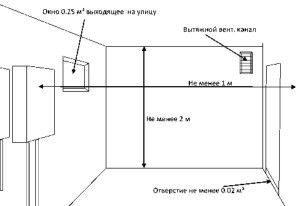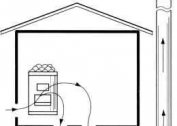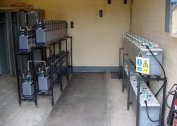 Gas combustion occurs with the release of carbon dioxide, nitrogen and water, and sometimes oxygen. When burning one cubic meter of gas, 9 cubic meters of air are used, about 8 cubic meters of combustion products and at least two cubic meters of steam are released. Ventilation for the boiler must provide both air supply and exhaust. It is necessary to ensure the removal of combustion products from each boiler separately. Lack of quality traction leads to accumulation of combustion products in the room, which is dangerous for human health. Exhaust ventilation for a gas boiler should be provided in advance.
Gas combustion occurs with the release of carbon dioxide, nitrogen and water, and sometimes oxygen. When burning one cubic meter of gas, 9 cubic meters of air are used, about 8 cubic meters of combustion products and at least two cubic meters of steam are released. Ventilation for the boiler must provide both air supply and exhaust. It is necessary to ensure the removal of combustion products from each boiler separately. Lack of quality traction leads to accumulation of combustion products in the room, which is dangerous for human health. Exhaust ventilation for a gas boiler should be provided in advance.
Ventilation for a gas boiler
Ventilation for the boiler is mounted only with natural draft. Forced ventilation can be dangerous in the event of a gas leak or boiler breakdown.
Exhaust ventilation for a gas boiler provides for the presence of a chimney. Since hot combustion products are smaller in density than air, they are discharged through a chimney going from the boiler to the street. The colder it is outside, the more efficient such an exhaust system will work. The calculation of ventilation when installing a gas boiler provides:
- Blowing in an hour is equal to a triple volume of air in the boiler room;
- The inflow makes up for the exhausted air plus provides the volume of air burned in the boiler.
The chimney parameters are determined on the basis of the temperature difference, the cross section of the pipe and relate to the mandatory calculations of ventilation when installing a gas boiler. The draft will be bad if the chimney pipe passes along the street and is not insulated.
Ventilation features for a gas boiler
From the ventilation pipe for the gas boiler to the walls should be at least 5 centimeters (if the walls are wooden at least 25 centimeters). No more than 3 turns of the chimney are allowed. The supply of air is ensured only through natural ventilation for the boiler. The easiest and most effective way to supply air to the boiler room is to install a window.
But when this is not possible, a supply air valve or an infiltration valve is mounted. The valve is a pipe, the length of which is determined by the owner, depending on the thickness of the wall. The diameter is selected depending on the capacity of the boiler (from 80 to 160 mm). From the inside, the valve itself is put on the pipe. Even in the most severe frosts, the device is not covered with ice. This is a very convenient and low-cost supply ventilation solution for the boiler, providing the necessary amount of oxygen to the burner and preventing cooling of the room, as it can be with a conventional window.


